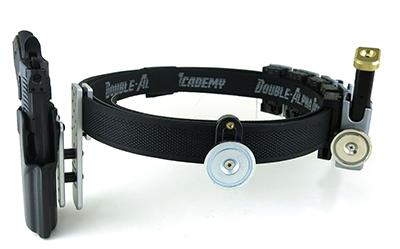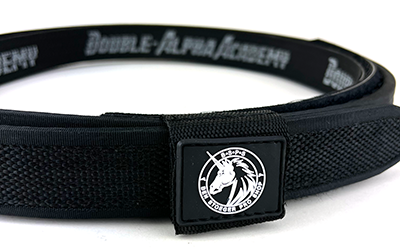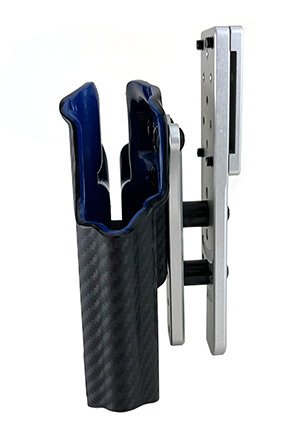Setting Up Your Belt Rig by Joel Park
Posted by Joel Park on Aug 20th 2022

Watching a top shooter perform a .80 draw and a sub-second reload is always impressive. The first thing that usually jumps out at me is the lack of wasted motion. Often, it doesn’t even look like the shooter has to try that hard; it just all seems to happen magically. I can’t promise to cut your draw time in half, but I would like to explain one way you may be able to shave some time off of your draw and mag changes. Having a rig set up properly can do just that. Here are some things I look for when setting up and adjusting my competition rig that will hopefully make you take a second look at the way your belt is set up.
For a competition rig, an inner and outer Velcro belt is without a doubt the way to go. The inner belt threads through your belt loops. You can attach your holster, mag pouches, magnet, caddys, etc. to the outer belt. The setup will guarantee all your equipment keeps the same spacing and makes it very easy to train for fast gun handling since your gear will be in the same place every time. I’ve had very good results using DAA and CR Speed double belt systems.

Unfortunately, just having your gear in the same spot every time won’t assure fast draws and reloads. The angle and location of your holster and mag pouches matters more than you might think. Obviously, not everyone is built the same; someone might be tall, short, long torso, short arms, long arms, and the list goes on. There are too many variables in the shooter’s physical build for a holster manufacturer to even try to accommodate, so the BOSS Dropped Offset Holster Hanger is instrumental in making your holster fit you. The BOSS has a mounting plate that securely attaches to your outer belt and features a ladder of holes and channels for mounting options. The mounting options allow you to adjust how high or low the gun sits from your belt and the channels towards the bottom allow you to tilt the gun muzzle forward or backwards.
The most important thing is being able to draw your handgun with the minimal amount of movement or wasted effort. With my hands relaxed naturally at my sides, I want to bring my hand directly to the handgun in a straight line and only need to close my fingers and thumb to get a full grip on the pistol, if possible. If you look very carefully, you will notice most people position their holster perfectly vertical and some shooters need to bend their wrist forward to allow the webbing of their hand between the thumb and index finger to fully contact the beavertail of the grip. Adjusting the holster height and canting the gun to be muzzle forward has been very helpful for shooters I have worked with. The last thing to check is making sure you comply with the holster placement and height rules for your division if you are a competitive shooter.

For holster manufacturers, I really like the GX Products Vice holster that features a clamp that increases the amount of resistance needed to draw the handgun. We’ve all seen shooters running with one hand holding their gun in the holster so it doesn’t fall out. The clamp lock on the holster keeps the gun in the holster until you are ready to draw. The tension on the Vice can also be adjusted. I have my Glock holster set with medium retention when the Vice is activated so I can run around on 2 Gun stages without worrying about my gun falling out, but I am still able to draw it with minimum effort. If you prefer a traditional style kydex holster, I have used a Long’s Shadow holster for several years without any issues. Long’s Shadow holsters fit the gun very well so the handgun doesn’t rattle around in them.
I feel that drawing a magazine from your mag pouch is just as critical as drawing your handgun from your holster. From your two-handed shooting grip, you should be able to move your support hand straight to the mag pouch and establish the full grip you want on the magazine without the following pouch or magazine getting in the way. I also tilt my pouches slightly backwards because it feels more natural to me when moving my hand directly to the pouches as I am gripping a magazine. Regardless of the relaxed USPSA equipment placement rules for magazine pouches, I still prefer to have my mag pouches start around by hip bone and move backwards in a row as opposed to moving pouches more towards the twelve o’clock position. It’s worth testing different placement and seeing what feels the most comfortable to you. As you adjust these, consider being able to find your third or fourth magazine easily if you are in a low-capacity division. For tension adjustment, I never adjust the pouches as loosely as they will go or until the magazine rattles around. I prefer to have a small amount of resistance when drawing a magazine and it should be tested that the mags will not fall out of your pouch while running hard or moving aggressively.
Another topic that comes up is whether to use mag pouches that face bullets nose out versus bullets forward. I’ve observed a lot of shooters being genuinely fast with both methods and I don’t think there is a clear winner. If you’re already comfortable with one style, I see very few reasons why you should switch, unless you just want to try something different.
I have used several brands of mag pouches and really like the CR Speed pouches due to how rugged they are. I haven’t really seen anything on the market to avoid or that is overly problematic. I think a fair amount of gear issues arise from poorly adjusted gear.
If you are in the market for new mag pouches or holsters, my advice is to check out the products your friends are using or message someone that uses the product you are considering so you can make an informed purchase. If you are happy with the gear you have, take a second look to make sure your holster and mag pouches are adjusted so they fit you and you can use them with the minimum amount of effort.
Joel Park
Host of
Training Group Live by PSTG podcast

